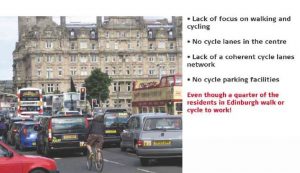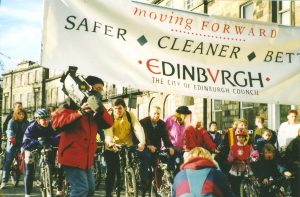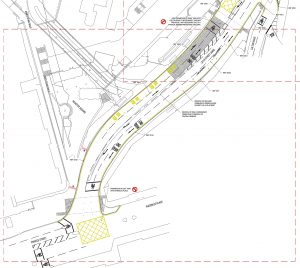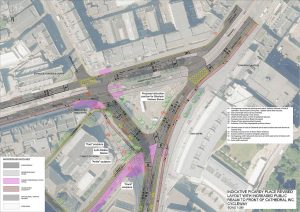Latest 6.12.17: ‘Picardy Group’ set up to oppose the Picardy Place gyratory plan. Manifesto Broughton Spurtle article
It is not widely realised that Edinburgh City Council has begun internal discussions on a potential major ‘Transformation’ of the City Centre…
We have no real insight into the initial ideas – but they certainly are likely to include options such as a truly pedestrian and cycle-friendly Princes Street, with most motor traffic removed, and the closure of other streets to through motor traffic. All relevant Council departments are apparently involved, not just transport, and the project is to be led through a Central Edinburgh Development Working Group which will include councillors from all 5 parties on the Council.

The 2010 Council-funded Gehl report; still sitting in the Council’s filing cabinet/website
The Transformation process follows years of ever-increasing pressure for a traffic-reduced people-friendly city centre as Edinburgh (and, notably, Scotland’s premier street, Princes Street) falls further behind comparable European cities.
It was back in 2010 that international ‘Cities for People’ expert Jan Gehl called Princes Street a ‘bus station’ and George Street a ‘car park’ in his neglected report on the city centre. Sadly the then Council bottled out of any serious implementation of Gehl’s report, falling back solely into consulting on the future of George Street (a process which still chunters on).
The new Transformation process was initiated by clause 5 of motion 9.1 at the first main meeting of the new City Council, on 29 June 2017, which agreed to create…
A medium-term action plan, to be implemented before the end of this Council term, to improve the public realm in the city centre with the aim of improving conditions for, and prioritising access for pedestrians, cyclists and public transport users…
A subsequent report, to the 5 October Transport and Environment Committee, fleshed out the process to be followed in developing the plan. The report recognises that…
- Edinburgh’s public realm does not always provide the best pedestrian experience … long-wait times at crossings frustrate safe and convenient movement
- cyclists (a healthy, accessible and pollution-free way to get around) must negotiate conflicts with cars, public transport, pedestrians
- there are several thousand bus movements per day on Princes St and crowded bus stops across the city
- congestion is exacerbated … due to delivery vehicles
- air quality … fails to meet Scottish Government standards.
As a result…
The project will involve rethinking transport priorities across the city in order to … provide a public realm that better meets the needs of residents, pedestrians, cyclists and a more integrated public transport network. … Edinburgh can learn from other leading cities.
A major public consultation on options is expected in the summer (we hope ‘stakeholder groups’ including Spokes and Living Streets will be informally consulted before that) with decisions by the end of the year on how to proceed.

1996: Transport Convener Cllr David Begg (yellow jacket) heads a procession opening the new Princes Street cycle lanes – scrapped by a later Council, but now hopefully an option for reinstatement, as a segregated facility, as part of the Transformation process
Hints from councillors and officers suggest that they are thinking boldly – and they will have to if they don’t wish to be overtaken by Glasgow, whose impressive recently announced Connectivity Commission is to be headed by UK transport expert Prof David Begg. David Begg was Edinburgh’s Transport Convener (and a Spokes member) in the 1990s and took many brave initiatives on buses, cycling and walking, several of which, unbelievably, subsequent councils dismantled – including scrapping the Princes St cycle lanes he had installed (see picture) and scrapping offpeak and Saturday bus lanes.
In London, Mayor Sadiq Khan has just released a draft London Plan aiming to significantly reduce car dependency. Its bold policies include a requirement for new housing and offices near public transport links to be car-free. Elsewhere, allowable car parking will be reduced and large houses permitted no more parking than smaller ones. The ‘healthy streets’ approach requires greatly enhanced bike parking & storage by developers. It aims for 70% of Londoners to be within 400m of a protected cycleroute by 2041 – already some Cycle Superhighways are “moving five times more people per square metre than the main carriageway.”
Spokes hugely welcomes Edinburgh’s Transformation process, as long as it is truly transformative and not gradually watered down in the face of motoring demands. And as long as it does not meet the filing-cabinet fate of the Gehl report.
Of course, decisions such as the future of Picardy Place and Leith Street should be part of this – to contribute to the Transformation, and to benefit from it. But, sadly, the juggernaut of the St James process began around a decade earlier, with huge investment implications for the city, with planning permission long since granted for an increase of roughly 1000 car spaces, and with a legal agreement for a car-dominated Picardy gyratory (with, apparently, heavy penalty clauses).
PICARDY PLACE
Spokes is unhappy with the basic gyratory concept and we associate ourselves with the positions put forward by Sustrans Scotland and by Living Streets. We do not need to duplicate the arguments here.
Latest!! A great background article by Cllr Scott Arthur, concluding in a plea for reconsideration by the Scottish Government, the developers and the Council of the GAM financial agreement which includes the gyratory plan.
Spokes has made a detailed submission on the latest Picardy plans and, if the gyratory remains, our top concerns are…
- The Council’s flagship West-East route, Roseburn to Leith via George Street, runs through Picardy Place. It must be direct and of high quality – but in the current plans it is seriously indirect, and its quality is compromised by diversion through a small and constricted pedestrian/cycle traffic island at the John Lewis corner. See this map illustration by Spokes member Chris Paton.
-
Maximum flexibility must be retained, to allow future adaptability in conjunction with the above City Centre Transformation. In particular, this means landscaping the big island inside the gyratory, not building on it
-
Broughton Street to/from Leith Street are important cycleroute connections – they must be direct and convenient
- Shared pedestrian/cycle space has been reduced, but should be replaced altogether with separate facilities, including side-by-side road crossings rather than shared ‘toucans.’
- Other issues – our submission also covers several other important issues.
It should be relatively simple to amend the plans to include most of these vital points and if that is done the new setup will be significantly more cycle-friendly than now – though the area as a whole will remain a 20th-century traffic-dominated solution rather than a 21st-century ‘place for people.’
On the other hand, if the gyratory is scrapped, then a better solution for cycling is possible – and a far better solution for pedestrians – albeit with a significant delay whilst new plans are drawn up and consulted on.
PICARDY PLACE – what you can do [closing date December 15]
Please make a personal submission to the consultation, emphasising the main points important to you – it does not need to be lengthy – a short email of main points is very worthwhile.
The Council consultation page is here and, for ease of reference, the consultation map is here. These and other useful links are also on our Leith Walk web page here (para 1711).
You can respond either using the online form on the Council consultation page or by sending an email to Craig.McConnell@edinburgh.gov.
LEITH STREET (1) – the closure
The current 10-month closure of Leith Street appears to be working reasonably well now that it has settled in. The recent Spokes traffic count near Greyfriar’s Bobby found a smaller rise in diverted motor traffic than might have been expected and it seems likely that some former motorists are now using alternate modes or alternate opportunities rather than driving on circuitous routes.
As with Picardy, Leith Street will be intimately involved in the City Centre Transformation, with the possibility that it could be permanently closed to through motor traffic other than buses. We therefore urge that the present car ban is maintained until the Transformation outcomes become clearer – buses should return to Leith Street as soon as possible, but it makes no sense to allow motorists to re-habituate themselves to using Leith Street if that may not be a long-term prospect and if meantime Leith Street could be a really people-friendly street.
It should also be noted that once buses are allowed back into Leith Street any car congestion on diversion routes will therefore be reduced. If, nonetheless, any residential streets have become rat-runs, then closure at one end of such streets should be considered.
LEITH STREET CLOSURE – what you can do [as soon as possible]
The Leith Street closure is for 10 months whilst St James works take place, and unless Councillors act it will reopen to all traffic at that time.
If you would like the closure to continue, at least until the Council’s City Centre Transformation project reaches some conclusions email your Councillors as soon as possible. Ask them to raise your concerns with the Transport Convener, Cllr Lesley Macinnes, and with the Council’s Transformation working party which we understand is now being set up.

Map 1 from the TRO Order, showing the top of Leith Street. Click to download pdf, or use the links in the text to check out the maps and other details from both Orders
LEITH STREET (2) – TRO/17/81 and RSO/17/13 Orders
Quite separately to the above, draft Orders have been published for the redesign of Leith Street. A Spokes submission is being prepared, but several issues already concern us greatly…
- the Leith Street bus lanes will be removed
- there is no uphill cycle lane beyond Calton Road, not even a painted one – although there are two uphill traffic lanes, including right up to the Waterloo Place junction. Nor is there a downhill lane, though that is less essential
- cycling up Leith Street, there is a segregated lane as far as Calton Rd, but no obvious safe way to then join the carriageway
- the segregated cycleway is 2.5m wide, narrowing to 2m at the bus stop. That is too narrow for a 2-way cycleroute
- cycling down Leith Street, there is no obvious way to join the segregated route which will run from Calton Road down to and along Leith Walk. Are you intended to use the gyratory?!
- there is potential cycle/ pedestrian conflict at the Greenside Row junction and elsewhere
- James Craig Walk is to become an important pedestrian/cycle route (to the new St James, possibly in future to/from St Andrews Square, and to York Place). A quality connection to Leith Street is essential, but not shown.
LEITH STREET TRAFFIC ORDERS – what you can do [closes 19 December ]
You can comment or object without going through the detail of the Orders, but if you wish to see them in detail they are on this Council page or click direct on RSO/17/13 and TRO/17/81.
The RSOs say what parts of the street will be carriageway, cycleroute and footway, whilst the TRO covers things like bus lanes and parking restrictions.
Unlike the above Picardy consultation, there is not an online consultation form. Instead, you send objections by email to trafficorders@edinburgh.gov.uk
If you wish to object just send one email, saying you object to both orders and quoting their above reference numbers. Then state your reasons and why it matters to you – either just a few bullet points or going into more detail. It is important to say ‘object’ rather than just ‘comment’ as this makes a public inquiry more likely. Please also forward your email to spokes@spokes.org.uk.

